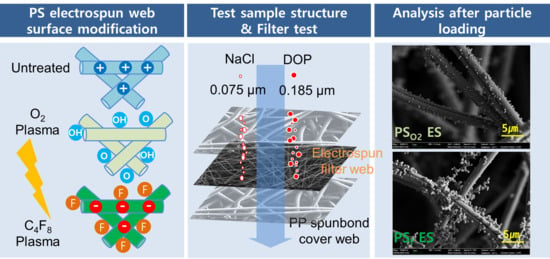Facile Functionalization via Plasma-Enhanced Chemical Vapor Deposition for the Effective Filtration of Oily Aerosol
Abstract
1. Introduction
2. Materials and Methods
2.1. Materials
2.2. Preparation of PS Electrospun Filter Media
2.3. Characterization
2.4. Filtration Performance
3. Results
3.1. Fabrication of Electrospun Media with Different Functionalities
3.2. Filtration Performance
4. Conclusions
Supplementary Materials
Author Contributions
Funding
Conflicts of Interest
References
- World Health Organization (W.H.O). Available online: https://www.who.int/en/news-room/fact-sheets/detail/ambient-(outdoor)-air-quality-and-health (accessed on 2 May 2018).
- Prussin, A.J.; Garcia, E.B.; Marr, L.C. Total Concentrations of Virus and Bacteria in Indoor and Outdoor Air. Environ. Sci. Tech. Lett. 2015, 2, 84–88. [Google Scholar] [CrossRef] [PubMed]
- Weber, S.A.; Insaf, T.Z.; Hall, E.S.; Talbot, T.O.; Huff, A.K. Assessing the impact of fine particulate matter (PM2.5) on respiratory cardiovascular chronic diseases in the New York City Metropolitan area using Hierarchical Bayesian Model estimates. Environ. Res. 2016, 151, 399–409. [Google Scholar] [CrossRef] [PubMed]
- Yan, D.; Zhang, T.; Su, J.; Zhao, L.L.; Wang, H.; Fang, X.M.; Zhang, Y.Q.; Liu, H.Y.; Yu, L.Y. Structural Variation in the Bacterial Community Associated with Airborne Particulate Matter in Beijing, China, during Hazy and Nonhazy Days. Appl. Environ. Microb. 2018, 84. [Google Scholar] [CrossRef] [PubMed]
- Zheng, H.; Qu, C.K.; Zhang, J.Q.; Talpur, S.A.; Ding, Y.; Xing, X.L.; Qi, S.H. Polycyclic aromatic hydrocarbons (PAHs) in agricultural soils from Ningde, China: Levels, sources, and human health risk assessment. Environ. Geochem. Health 2019, 41, 907–919. [Google Scholar] [CrossRef] [PubMed]
- Rengasamy, S.; Eimer, B.C.; Shaffer, R.E. Comparison of Nanoparticle Filtration Performance of NIOSH-approved and CE-Marked Particulate Filtering Facepiece Respirators. Ann. Occup Hyg. 2009, 53, 117–128. [Google Scholar] [CrossRef] [PubMed]
- Wang, H.M.; Zhao, H.B.; Wang, K.; Zheng, C.G. Simulating and Modeling Particulate Removal Processes by Elliptical Fibers. Aerosol. Sci. Tech. 2014, 48, 207–218. [Google Scholar] [CrossRef][Green Version]
- Zhu, M.M.; Han, J.Q.; Wang, F.; Shao, W.; Xiong, R.H.; Zhang, Q.L.; Pan, H.; Yang, Y.; Samal, S.K.; Zhang, F.; et al. Electrospun Nanofibers Membranes for Effective Air Filtration. Macromol. Mater. Eng. 2017, 302. [Google Scholar] [CrossRef]
- Kim, J.; Jasper, W.; Hinestroza, J. Direct probing of solvent-induced charge degradation in polypropylene electret fibres via electrostatic force microscopy. J. Microsc.-Oxford 2007, 225, 72–79. [Google Scholar] [CrossRef] [PubMed]
- Joe, Y.H.; Shim, J.; Shin, W.G.; Park, H.S. Effects of an external electric field on the collection efficiency of air filters: Filtration mechanisms with an external e-field. Aerosol. Sci. Tech. 2017, 51, 1409–1418. [Google Scholar] [CrossRef]
- Lolla, D.; Lolla, M.; Abutaleb, A.; Shin, H.U.; Reneker, D.H.; Chase, G.G. Fabrication, Polarization of Electrospun Polyvinylidene Fluoride Electret Fibers and Effect on Capturing Nanoscale Solid Aerosols. Materials 2016, 9, 671. [Google Scholar] [CrossRef] [PubMed]
- Tang, M.; Chen, S.C.; Chang, D.Q.; Xie, X.F.; Sun, J.; Pui, D.Y.H. Filtration efficiency and loading characteristics of PM2.5 through composite filter media consisting of commercial HVAC electret media and nanofiber layer. Sep. Purif. Technol. 2018, 198, 137–145. [Google Scholar] [CrossRef]
- CDC-NIOSH. NIOSH-Approved Particulate Filtering Facepiece Respirators. Available online: https://www.cdc.gov/niosh/npptl/topics/respirators/disp_part/default.html (accessed on 6 December 2018).
- Gao, H.C.; Yang, Y.Q.; Akampumuza, O.; Hou, J.; Zhang, H.N.; Qin, X.H. A low filtration resistance three-dimensional composite membrane fabricated via free surface electrospinning for effective PM2.5 capture. Environ. Sci. Nano 2017, 4, 864–875. [Google Scholar] [CrossRef]
- Khalid, B.; Bai, X.P.; Wei, H.H.; Huang, Y.; Wu, H.; Cui, Y. Direct Blow-Spinning of Nanofibers on a Window Screen for Highly Efficient PM2.5 Removal. Nano Lett. 2017, 17, 1140–1148. [Google Scholar] [CrossRef] [PubMed]
- Souzandeh, H.; Scudiero, L.; Wang, Y.; Zhong, W.H. A Disposable Multi-Functional Air Filter: Paper Towel/Protein Nanofibers with Gradient Porous Structures for Capturing Pollutants of Broad Species and Sizes. ACS Sustain. Chem. Eng. 2017, 5, 6209–6217. [Google Scholar] [CrossRef]
- Zhang, R.F.; Liu, C.; Hsu, P.C.; Zhang, C.F.; Liu, N.; Zhang, J.S.; Lee, H.R.; Lu, Y.Y.; Qiu, Y.C.; Chu, S.; et al. Nanofiber Air Filters with High-Temperature Stability for Efficient PM2.5 Removal from the Pollution Sources. Nano Lett. 2016, 16, 3642–3649. [Google Scholar] [CrossRef] [PubMed]
- Zhang, S.C.; Liu, H.; Yin, X.; Yu, J.Y.; Ding, B. Anti-deformed Polyacrylonitrile/Polysulfone Composite Membrane with Binary Structures for Effective Air Filtration. ACS Appl. Mater. Inter. 2016, 8, 8086–8095. [Google Scholar] [CrossRef] [PubMed]
- Zhang, S.C.; Tang, N.; Cao, L.T.; Yin, X.; Yu, J.Y.; Ding, B. Highly Integrated Polysulfone/Polyacrylonitrile/Polyamide-6 Air Filter for Multilevel Physical Sieving Airborne Particles. ACS Appl. Mater. Inter. 2016, 8, 29062–29072. [Google Scholar] [CrossRef] [PubMed]
- Zhao, X.L.; Li, Y.Y.; Hua, T.; Jiang, P.; Yin, X.; Yu, J.Y.; Ding, B. Low-Resistance Dual-Purpose Air Filter Releasing Negative Ions and Effectively Capturing PM2.5. ACS Appl. Mater. Inter. 2017, 9, 12054–12063. [Google Scholar] [CrossRef]
- Zhang, S.; Shim, W.S.; Kim, J. Design of ultra-fine nonwovens via electrospinning of Nylon 6: Spinning parameters and filtration efficiency. Mater. Des. 2009, 30, 3659–3666. [Google Scholar] [CrossRef]
- Jasper, W.; Hinestroza, J.; Mohan, A.; Kim, J.; Shiels, B.; Gunay, M.; Thompson, D.; Barker, R. Effect of xylene exposure on the performance of electret filter media. J. Aerosol. Sci 2006, 37, 903–911. [Google Scholar] [CrossRef]
- Vanangamudi, A.; Hamzah, S.; Singh, G. Synthesis of hybrid hydrophobic composite air filtration membranes for antibacterial activity and chemical detoxification with high particulate filtration efficiency (PFE). Chem. Eng. J. 2015, 260, 801–808. [Google Scholar] [CrossRef]
- Choi, J.; Yang, B.J.; Bae, G.N.; Jung, J.H. Herbal Extract Incorporated Nanofiber Fabricated by an Electrospinning Technique and its Application to Antimicrobial Air Filtration. ACS Appl. Mater. Inter. 2015, 7, 25313–25320. [Google Scholar] [CrossRef] [PubMed]
- Kim, J.; Hong, S.C.; Bae, G.N.; Jung, J.H. Electrospun Magnetic Nanoparticle-Decorated Nanofiber Filter and Its Applications to High-Efficiency Air Filtration. Environ. Sci. Technol. 2017, 51, 11967–11975. [Google Scholar] [CrossRef] [PubMed]
- Huang, X.X.; Jiao, T.F.; Liu, Q.Q.; Zhang, L.X.; Zhou, J.X.; Li, B.B.; Peng, Q.M. Hierarchical electrospun nanofibers treated by solvent vapor annealing as air filtration mat for high-efficiency PM2.5 capture. Sci. China Mater. 2019, 62, 423–436. [Google Scholar] [CrossRef]
- Lubasova, D.; Netravali, A.; Parker, J.; Ingel, B. Bacterial filtration efficiency of green soy protein based nanofiber air filter. J. Nanosci. Nanotechnol. 2014, 14, 4891–4898. [Google Scholar] [CrossRef]
- Joe, Y.H.; Woo, K.; Hwang, J. Fabrication of an anti-viral air filter with SiO2–Ag nanoparticles and performance evaluation in a continuous airflow condition. J. Hazard. Mater. 2014, 280, 356–363. [Google Scholar] [CrossRef]
- Liu, X.B.; Souzandeh, H.; Zheng, Y.D.; Xie, Y.J.; Zhong, W.H.; Wang, C. Soy protein isolate/bacterial cellulose composite membranes for high efficiency particulate air filtration. Compos. Sci. Technol. 2017, 138, 124–133. [Google Scholar] [CrossRef]
- Souzandeh, H.; Johnson, K.S.; Wang, Y.; Bhamidipaty, K.; Zhong, W.H. Soy-Protein-Based Nanofabrics for Highly Efficient and Multifunctional Air Filtration. ACS Appl. Mater. Inter. 2016, 8, 20023–20031. [Google Scholar] [CrossRef]
- Wang, C.Y.; Wu, S.Y.; Jian, M.Q.; Xie, J.R.; Xu, L.P.; Yang, X.D.; Zheng, Q.S.; Zhang, Y.Y. Silk nanofibers as high efficient and lightweight air filter. Nano Res. 2016, 9, 2590–2597. [Google Scholar] [CrossRef]
- Wang, Y.; Li, W.; Xia, Y.; Jiao, X.; Chen, D. Electrospun flexible self-standing γ-alumina fibrous membranes and their potential as high-efficiency fine particulate filtration media. J. Mater. Chem. A 2014, 2, 15124–15131. [Google Scholar] [CrossRef]
- Wang, Z.; Zhao, C.C.; Pan, Z.J. Porous bead-on-string poly(lactic acid) fibrous membranes for air filtration. J. Colloid Interf. Sci. 2015, 441, 121–129. [Google Scholar] [CrossRef]
- Bourrous, S.; Bouilloux, L.; Ouf, F.X.; Lemaitre, P.; Nerisson, P.; Thomas, D.; Appert-Collin, J.C. Measurement and modeling of pressure drop of HEPA filters clogged with ultrafine particles. Powder Technol. 2016, 289, 109–117. [Google Scholar] [CrossRef]
- Gao, X.C.; Gou, J.; Zhang, L.; Duan, S.S.; Li, C.Z. A silk fibroin based green nano-filter for air filtration. RSC Adv. 2018, 8, 8181–8189. [Google Scholar] [CrossRef]
- Sun, Z.; Tang, M.; Song, Q.; Yu, J.; Liang, Y.; Hu, J.; Wang, J. Filtration performance of air filter paper containing kapok fibers against oil aerosols. Cellulose 2018, 25, 6719–6729. [Google Scholar] [CrossRef]
- Gristina, R.; D’Aloia, E.; Senesi, G.S.; Millella, A.; Nardulli, M.; Sardella, E.; Favia, P.; d’Agostino, R. Increasing Cell Adhesion on Plasma Deposited Fluorocarbon Coatings by Changing the Surface Topography. J. Biomed. Mater. Res. B 2009, 88, 139–149. [Google Scholar] [CrossRef]
- Kim, S.H.; Kim, J.-H.; Kang, B.-K.; Uhm, H.S. Superhydrophobic CFx Coating via In-Line Atmospheric RF Plasma of He– CF4– H2. Langmuir 2005, 21, 12213–12217. [Google Scholar] [CrossRef]
- Riccardi, C.; Barni, R.; Fontanesi, M.; Marcandalli, B.; Massafra, M.; Selli, E.; Mazzone, G. A SF6 RF plasma reactor for research on textile treatment. Plasma Sources Sci. Technol. 2001, 10, 92–98. [Google Scholar] [CrossRef]
- Samanta, K.K.; Jassal, M.; Agrawal, A.K. Improvement in water and oil absorbency of textile substrate by atmospheric pressure cold plasma treatment. Surf. Coat. Tech. 2009, 203, 1336–1342. [Google Scholar] [CrossRef]
- Stallard, C.P.; McDonnell, K.A.; Onayemi, O.D.; O’Gara, J.P.; Dowling, D.P. Evaluation of Protein Adsorption on Atmospheric Plasma Deposited Coatings Exhibiting Superhydrophilic to Superhydrophobic Properties. Biointerphases 2012, 7. [Google Scholar] [CrossRef]
- Tsougeni, K.; Vourdas, N.; Tserepi, A.; Gogolides, E.; Cardinaud, C. Mechanisms of Oxygen Plasma Nanotexturing of Organic Polymer Surfaces: From Stable Super Hydrophilic to Super Hydrophobic Surfaces. Langmuir 2009, 25, 11748–11759. [Google Scholar] [CrossRef]
- Yuan, Y.; Choi, S.O.; Kim, J. Analysis of contact area between water and irregular fibrous surface for prediction of wettability. RSC Adv. 2016, 6, 73313–73322. [Google Scholar] [CrossRef]
- Song, K.; Lee, J.; Choi, S.O.; Kim, J. Interaction of Surface Energy Components between Solid and Liquid on Wettability, and Its Application to Textile Anti-Wetting Finish. Polymers 2019, 11, 498. [Google Scholar] [CrossRef]
- Yuan, Y.; Hays, M.P.; Hardwidge, P.R.; Kim, J. Surface characteristics influencing bacterial adhesion to polymeric substrates. RSC Adv. 2017, 7, 14254–14261. [Google Scholar] [CrossRef]
- Owens, D.K.; Wendt, R. Estimation of the surface free energy of polymers. J. Appl. Polym. Sci. 1969, 13, 1741–1747. [Google Scholar] [CrossRef]
- Chen, L.F.; Ding, S.R.; Liang, Z.R.; Zhou, L.; Zhang, H.X.; Zhang, C.Q. Filtration efficiency analysis of fibrous filters: Experimental and theoretical study on the sampling of agglomerate particles emitted from a GDI engine. Aerosol. Sci. Tech. 2017, 51, 1082–1092. [Google Scholar] [CrossRef]
- Kuo, J. Air Pollution Control.: Engineering for Environmental Engineers, 1st ed.; CRC Press: Boca Raton, FL, USA, 2018. [Google Scholar]
- Wang, S.; Zhao, X.; Yin, X.; Yu, J.; Ding, B. Electret polyvinylidene fluoride nanofibers hybridized by polytetrafluoroethylene nanoparticles for high-efficiency air filtration. ACS Appl. Mater. Inter. 2016, 8, 23985–23994. [Google Scholar] [CrossRef]
- Janczuk, B.; Zdziennicka, A. A study on the components of surface free energy of quartz from contact angle measurements. J. Mater. Sci. 1994, 29, 3559–3564. [Google Scholar] [CrossRef]
- Cho, B.M.; Nam, Y.S.; Cheon, J.Y.; Park, W.H. Residual Charge and Filtration Efficiency of Polycarbonate Fibrous Membranes Prepared by Electrospinning. J. Appl. Polym. Sci. 2015, 132. [Google Scholar] [CrossRef]

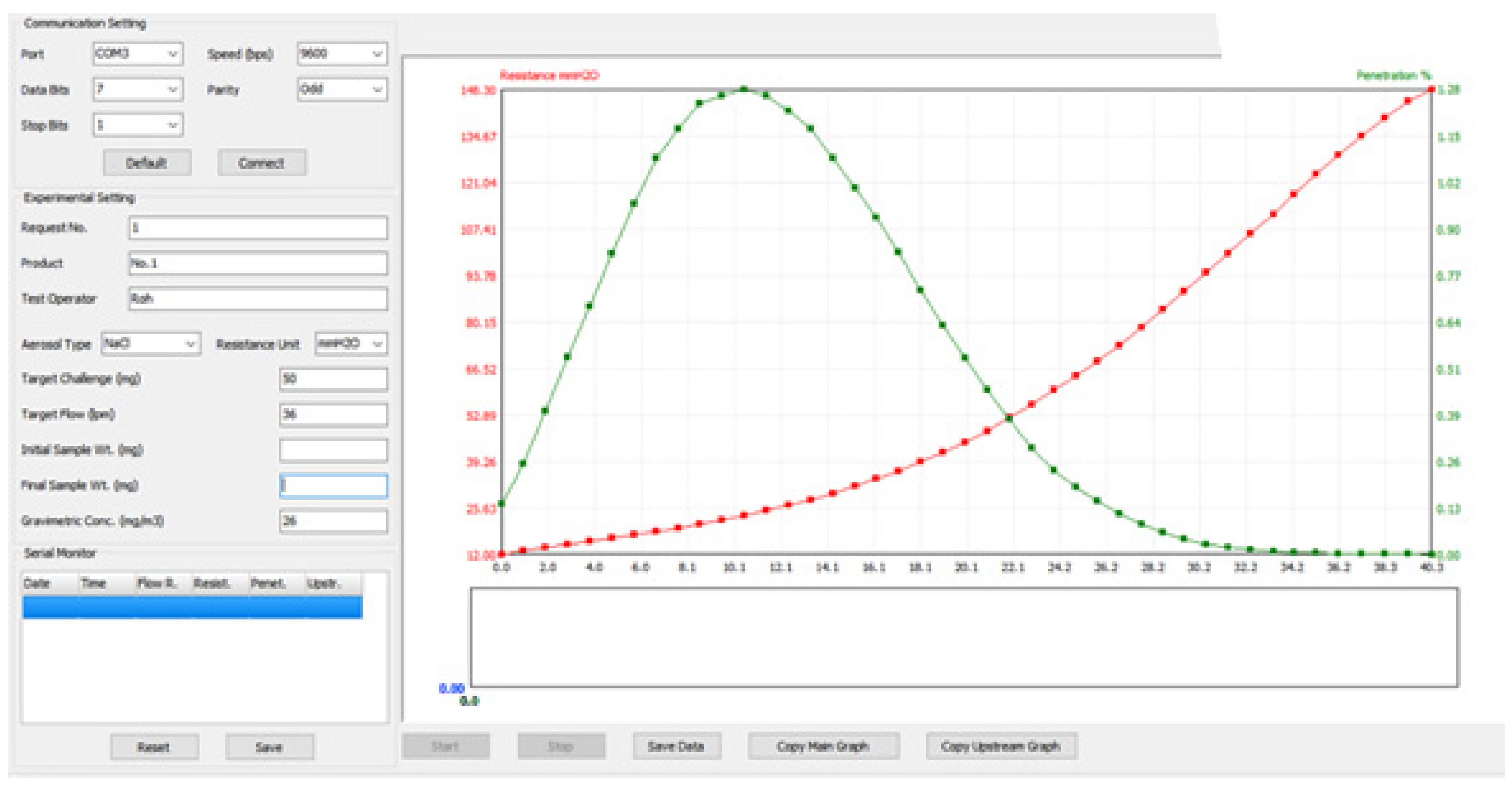
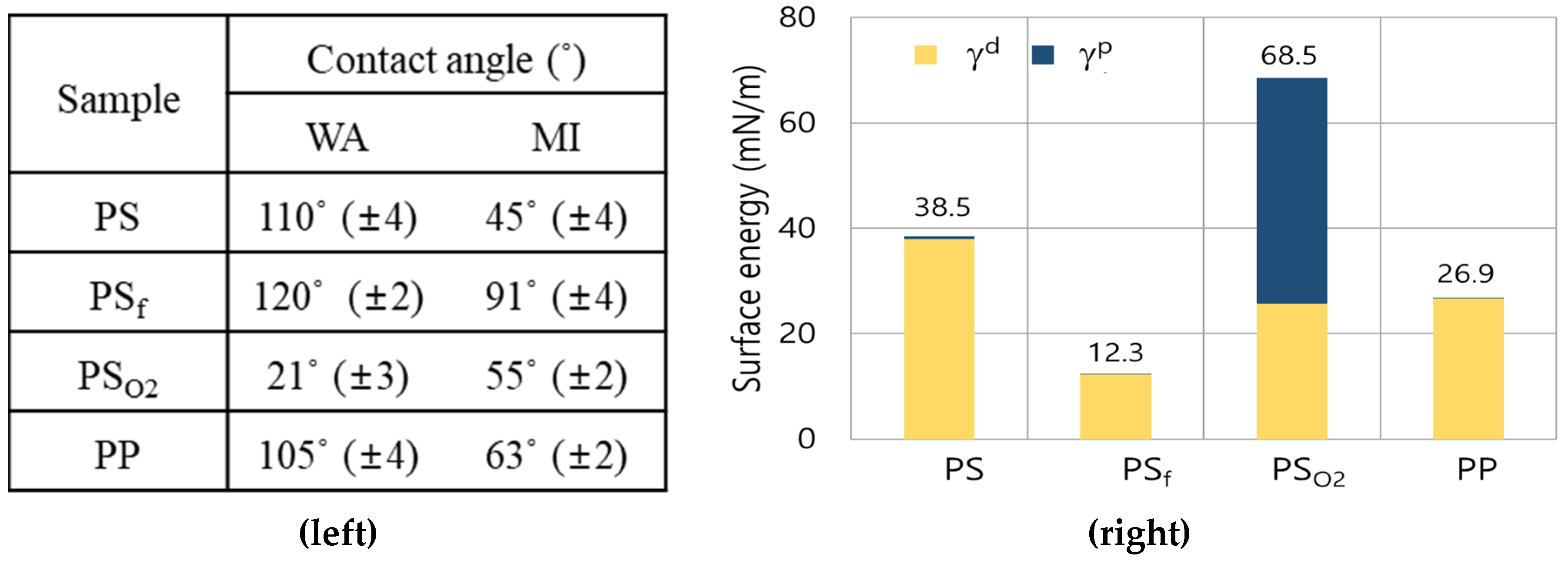

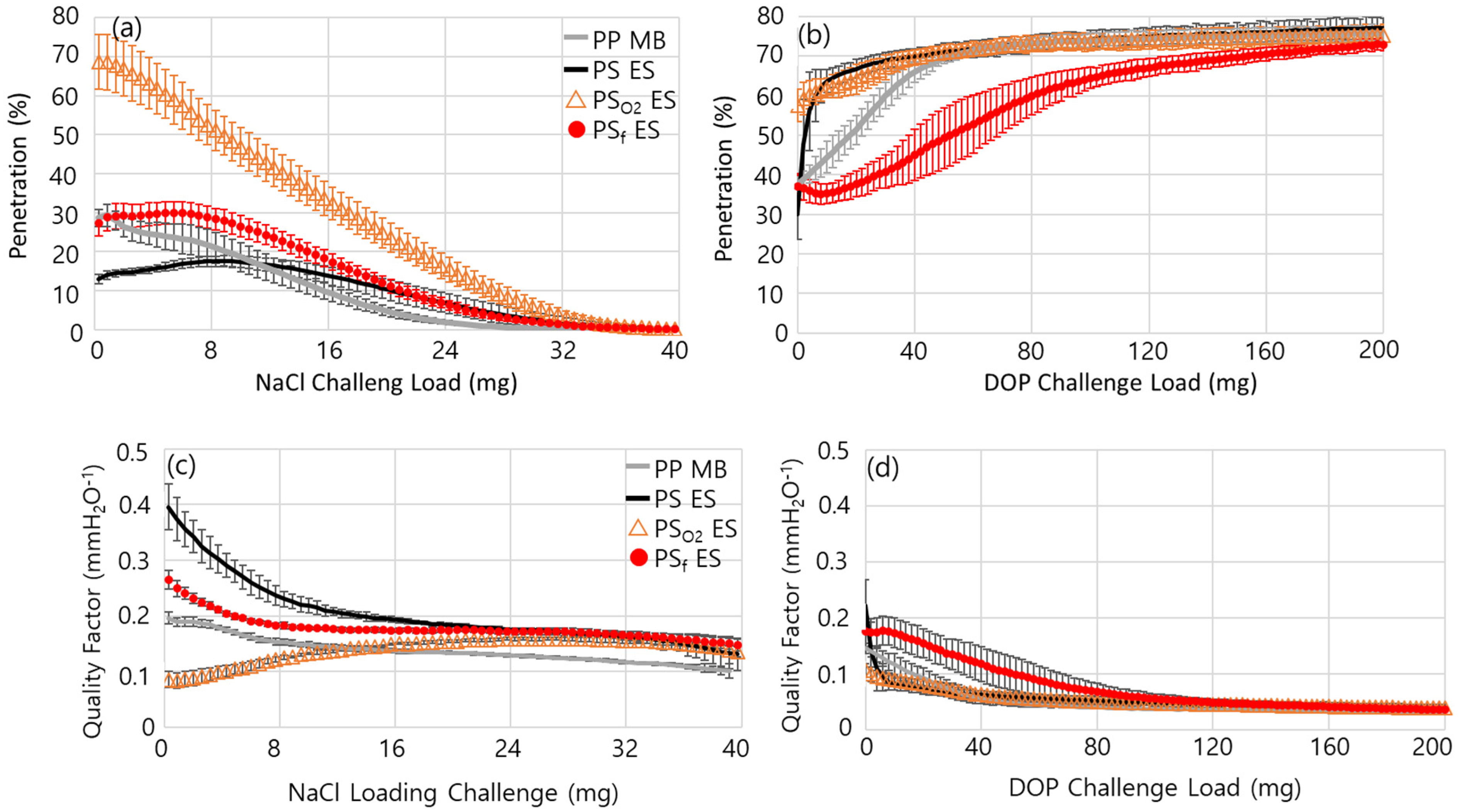
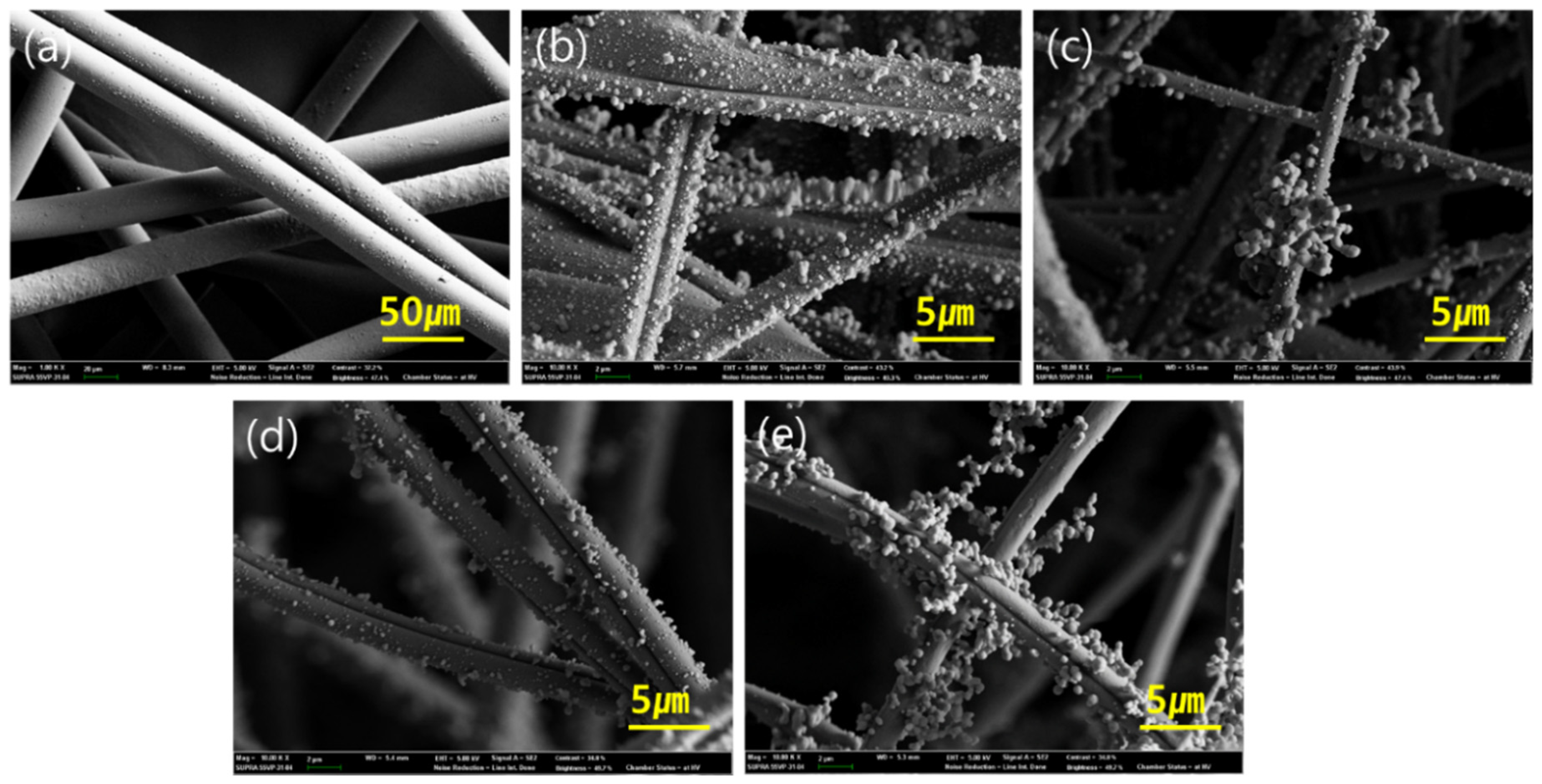
| Web | BW (g/m2) | Thickness (mm) | EFD (μm) | Measured Dia. (μm) |
|---|---|---|---|---|
| PP SB | 23 (±1) | 0.23 (±0.04) | 25.0 | 23.0 (±1.5) |
| PP MB | 30 (±2) | 0.32 (±0.07) | 5.1 | 4.1 (±1.5) |
| PS ES | 14 (±1) | 0.13 (±0.03) | 3.7 | 2.2 (±1.1) |
| PSf ES | 13 (±3) | 0.13 (±0.02) | 3.5 | 2.5 (±1.3) |
| PSO2 ES | 10 (±1) | 0.10 (±0.03) | 3.3 | 3.1 (±1.5) |
| CA or ShA | PS ES | PSO2 ES | PSf ES | PP SB | PP MB |
|---|---|---|---|---|---|
| WA CA (°) | 157° (±1) | 0° | 159° (±4) | 154° (±3) | 155° (±2) |
| WA ShA (°) | 41° (±1) | NA | 11° (±2) | 34° (±2) | 14° (±1) |
| DOP CA (°) | 0° (NA) | 0° (NA) | 149° (±2) | 0° (NA) | 0° (NA) |
| Specimen | C (%) | O (%) | F (%) |
|---|---|---|---|
| PS | 100 | - | - |
| PSO2 | 84.71 | 15.29 | - |
| PSf | 70.87 | - | 29.13 |
| PP | 100 | - | - |
| PP MB | PP SB | PS ES | PSO2 ES | PSf ES |
|---|---|---|---|---|
| −3.5 kV (±0.7) | −0.5 kV (±0.1) | 3.7 kV (±0.5) | 1.2 kV (±0.2) | −3.9 kV (±0.5) |
| Title | PS ES | PSO2 ES | PSf ES | PP MB |
|---|---|---|---|---|
| Initial resistance (mmH2O) | 5.4 (±0.3) | 4.8 (±0.6) | 5.3 (±0.6) | 6.6 (±0.6) |
| NaCl initial Pn (%) | 13.0 (±1.3) | 68.6 (±7.0) | 27.3 (±3.4) | 28.7 (±2.1) |
| NaCl max. Pn (%) | 17.8 (±1.4) | 68.9 (±7.0) | 30.0 (±2.9) | 29.4 (±2.7) |
| Challenge load of NaCl at max. Pn (%) | 8.8 (±1.7) | 0.5 (±0) | 5.8 (±0.5) | 1.1 (±0) |
| DOP initial Pn (%) | 29.9 (±6.2) | 57.6 (±4.1) | 37.1 (±3.3) | 37.6 (±1.8) |
| DOP max Pn at 200 mg load (%) | 77.0 (±2.5) | 75.3 (±2.7) | 73.0 (±1.7) | 75.8 (±1.7) |
© 2019 by the authors. Licensee MDPI, Basel, Switzerland. This article is an open access article distributed under the terms and conditions of the Creative Commons Attribution (CC BY) license (http://creativecommons.org/licenses/by/4.0/).
Share and Cite
Roh, S.; Kim, S.; Kim, J. Facile Functionalization via Plasma-Enhanced Chemical Vapor Deposition for the Effective Filtration of Oily Aerosol. Polymers 2019, 11, 1490. https://doi.org/10.3390/polym11091490
Roh S, Kim S, Kim J. Facile Functionalization via Plasma-Enhanced Chemical Vapor Deposition for the Effective Filtration of Oily Aerosol. Polymers. 2019; 11(9):1490. https://doi.org/10.3390/polym11091490
Chicago/Turabian StyleRoh, Sanghyun, Sungmin Kim, and Jooyoun Kim. 2019. "Facile Functionalization via Plasma-Enhanced Chemical Vapor Deposition for the Effective Filtration of Oily Aerosol" Polymers 11, no. 9: 1490. https://doi.org/10.3390/polym11091490
APA StyleRoh, S., Kim, S., & Kim, J. (2019). Facile Functionalization via Plasma-Enhanced Chemical Vapor Deposition for the Effective Filtration of Oily Aerosol. Polymers, 11(9), 1490. https://doi.org/10.3390/polym11091490




